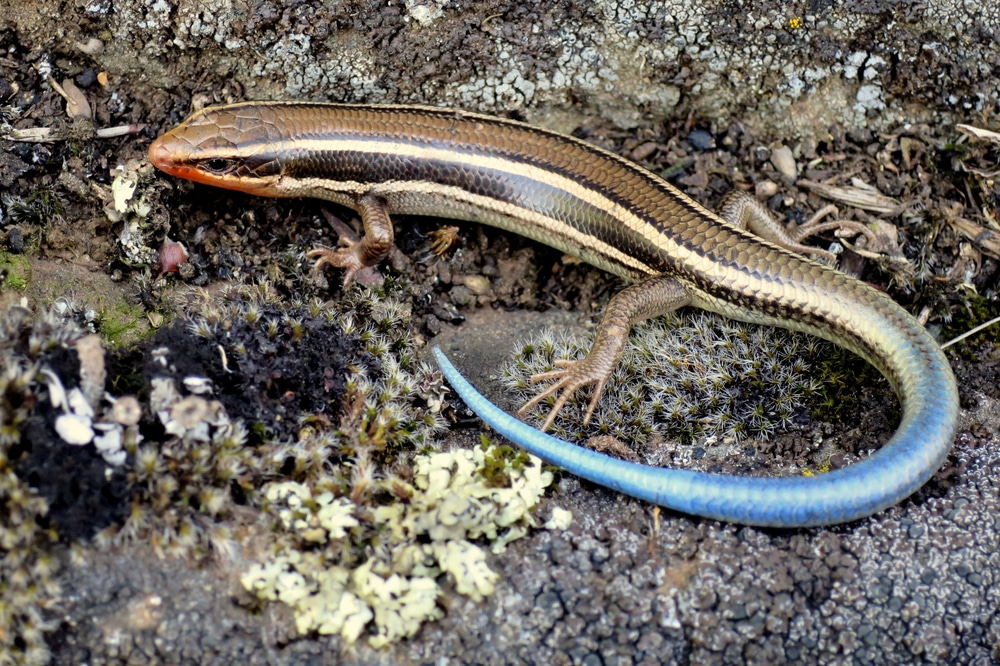

Broad-headed skinks live all over the southeastern United States, eating a wide variety of insects, spiders and invertebrates. Plestiodon fasciatus, of course, does have that common name sometimes in North America, even though as adults they lose the blue tails.Īs adults, broad-headed skinks turn mostly brown or olive brown, with the males getting the big, angular heads the species is named for, in a bright red color. To add to the confusion, despite having blue tails as youngsters, none of these lizards are the “ blue-tailed skink“, Cryptoblepharus egeriae, which lives on Australia’s Christmas Island and nowhere else. (With apologies to the Virginia Herpetological Society, who made these excellent images, I’m just going to mirror them here, because they are so very useful): The broad-headed skink is differentiated from the other two by its five, rather than four, labial scales. You can tell the five-lined skinks apart if you can turn them over: the common five-lined skink has a line of broad scales down the ventral centerline of its tail, and the southeastern has lots of little, same-size scales. The southeastern five-lined skink and the common five-lined skink both look a lot like the image above as youngsters. Juvenile broad-headed skink ( Plestiodon laticeps)įlorida is home to three Plestiodon species, which all look very similar as juveniles.They drop their tail when threatened or attacked and will regrow another one although it will be smaller. We get heaps of them in our house and they are lovely. It will regenerate later on, though the color and details will be entirely different from the original body.” You see, when and if the lizard feels threatened, it has the ability to detach its tail to confuse predators. Its tail is used for extra fat storage and also as a useful defense mechanism. With it’s big, leafy-looking tail, the gecko blends in perfectly. First of all, it will lay perfectly flat on the bark of a tree to camouflage itself when not hunting. It truly is a master of disguise – and deception. The site states: “This cryptic creature is the Broad-tailed Gecko or Southern Leaf-tailed Gecko (Phyllurus platurus ). The Southern Leaf Tailed Gecko, Phyllurus platurus, pictured on Featured Creature looks spot on. Thanks for writing back with the actual species. You’ve put me on the right track to what I now believe to be the tail section from a broad leaf tailed gecko. I can’t believe hadn’t even considered that it might not be a complete creature. Males have a squeaky high-pitched territorial call that sounds like a bird chirping.” According to the Florida Fish and Wildlife Conservation Commission: “Threats to natives: None known.”

They are extremely vocal – if they are in or around the house you will hear them. Mediterranean geckos move and hunt at night. They feed on moths, cockroaches and other insects and are rarely found far from houses and people.

Geckos are ‘sit-and-wait’ predators, usually seen on walls and ceilings inside houses, or where ever there is an outdoor light. There are no native nocturnal lizards in Florida, and geckos seem to have filled the niche. As their name suggests, Mediterranean geckos are native to Europe, but they are highly successful colonizers and well established in Florida. There have raised white spots on the back and sides. These geckos change color – at night they are light gray to white, during the day they become grayish with light pink and dark brown spots. Your lizard looks like the Mediterranean Gecko, Hemidactylus turcicus, pictured on Wild Florida where it states: “Mediterranean Geckos are small, rough-scaled geckos, with large lidless eyes, broad sticky toe pads and a long tail.


 0 kommentar(er)
0 kommentar(er)
